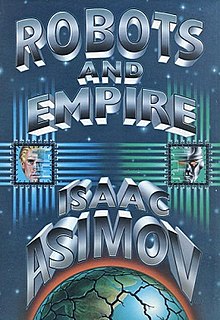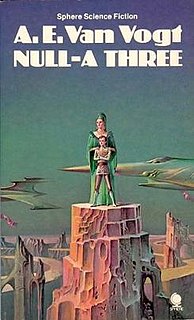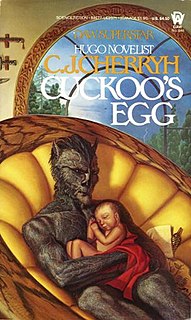Related Research Articles

The Forge of God is a 1987 science fiction novel by American writer Greg Bear. Earth faces destruction when an inscrutable and overwhelming alien form of life attacks.

Foundation and Earth is a science fiction novel by American writer Isaac Asimov, the fifth novel of the Foundation series and chronologically the last in the series. It was published in 1986, four years after the first sequel to the Foundation trilogy, which is titled Foundation's Edge.

The Memory of Whiteness is a science fiction novel written by Kim Stanley Robinson and published in September 1985. It shares with the Mars trilogy a focus on human colonization of the Solar System and depicts a grand tour that travels from the outer planets inward toward the Sun, visiting many human colonies along the way. The different human societies on the various planets and planetoids visited are depicted in detail. The purpose of the tour is to stage concerts by the "Holywelkin Orchestra", a futuristic musical instrument played by a selected master. Readers follow the Orchestra and its entourage together with a journalist, who after some time detects a conspiracy that seems to be connected with a group of gray-clad, sun-worshipping monks. The tour ends near the planet Mercury in a solar station belonging to these "Grays", which controls the white line energy source for the whole Solar System.

Robots and Empire is a science fiction novel by the American author Isaac Asimov, published by Doubleday Books in 1985. It is part of Asimov's Robot series, which consists of many short stories and five novels.

Man of Two Worlds (1986) is a science fiction novel by American writers Brian and Frank Herbert.

Null-A Three, usually written Ā Three, is a 1985 science fiction novel by A. E. van Vogt. It incorporates concepts from the General semantics of Alfred Korzybski and refers to non-Aristotelian logic.

Forty Thousand in Gehenna, alternately 40,000 in Gehenna, is a 1983 science fiction novel by American writer C. J. Cherryh. It is set in her Alliance-Union universe between 2354 and 2658, and is one of the few works in that universe to portray the Union side; other exceptions include Cyteen (1988) and Regenesis (2009).

Cuckoo's Egg is a science fiction novel by American writer C. J. Cherryh, which introduces a fictional race raising a human boy. It was published by DAW Books in 1985, and there was also a limited hardcover printing by Phantasia Press in the same year. The book was nominated for the Hugo Award and longlisted the Locus Award for Best Novel. It was later reprinted along with Cherryh's novel Serpent's Reach in the 2005 omnibus volume The Deep Beyond.

His Master's Voice is a 1960s science fiction novel written by Polish writer Stanisław Lem. It was first published in 1968 and translated into English by Michael Kandel in 1983. The book incorporates a "message from space" theme. It is a densely philosophical first contact story about an effort by scientists to decode, translate, and understand an extraterrestrial transmission. The novel critically approaches humanity's intelligence and intentions in deciphering and truly comprehending a message from outer space. It is considered to be one of the three best-known books by Lem, the other two being Solaris and The Cyberiad.

I Hope I Shall Arrive Soon is a book by American writer Philip K. Dick, a collection of 10 science fiction short stories and one essay. It was first published by Doubleday in 1985 and was edited by Mark Hurst and Paul Williams. Many of the stories had originally appeared in the magazines Fantasy and Science Fiction, Worlds of Tomorrow, Amazing Stories, Interzone, Rolling Stone College Papers, The Yuba City High Times, Omni and Playboy.

The Mirror of Her Dreams is a novel by Stephen R. Donaldson published in 1986.

Anthony Phillip Mann was a British-born New Zealand science fiction author. He studied English and drama at Manchester University and later in California before moving to New Zealand where he established the first drama studies position at a New Zealand university in 1970; at the Victoria University of Wellington in Wellington. He retired from the position of professor of drama at Victoria in 1998 to concentrate on other projects.
Helliconia Winter is a novel by Brian W. Aldiss published in 1985.

Black Star Rising, published in 1986, is a dystopian science fiction novel by American author Frederik Pohl. It is about a post-nuclear war future in which a conquered United States becomes a Chinese farming colony. The main character is an American who the Chinese send to meet a race of warlike aliens who come to Earth.

Converts is a novel by Ian Watson published in 1984.
Escape Plans is a novel by Gwyneth Jones published in 1986.
The Others is a novel by Alison Prince published in 1986.
Dinner at Deviant's Palace is a novel by Tim Powers published in 1985.
The Fall of the Families is a novel by Phillip Mann published in 1987, a sequel of Master of Paxwax from 1986.

Chernobyl is a novel by Frederik Pohl published in 1987. It is based on the 1986 Chernobyl disaster.
References
- ↑ Title: Master of Paxwax, www.isfdb.org
- 1 2 Langford, Dave (October 1986). "Critical Mass". White Dwarf . No. 82. Games Workshop. p. 8.